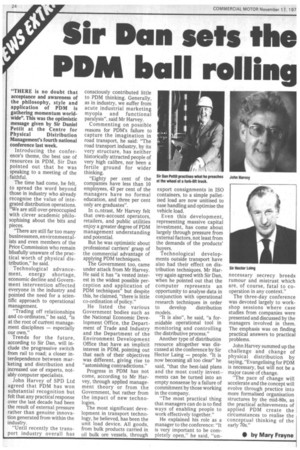Sir Dan sets the PDM ball rolling
Page 28

If you've noticed an error in this article please click here to report it so we can fix it.
"THERE is no doubt that acceptance and awareness of the philosophy, style and application of PDM is gathering momentum worldwide". This was the optimistic message given by Sir Daniel Pettit at the Centre for Physical Distribution Management's fourth national conference last week.
Introducing the conference's theme, the best use of resources in PDM, Sir Dan pointed out that he was speaking to a meeting of the faithful.
The time had come, he felt, to spread the word beyond those in industry who already recognise the value of integrated distribution operations. "We are still over-preoccupied with clever academic philosophising about the bits and pieces.
"There are still far too many businessmen, environmentalists and even members of the Price Commission who remain blissfully unaware of the practical worth of physical distribution," he said.
Technological advancement, energy shortage, economic decline and Government intervention affected everyone in the industry and pointed the need for a scientific approach to operational management.
"Trading off relationships and co-ordinates," he said, "is at the root of current management disciplines — especially our own."
Trends for the future, according to Sir Dan, will include the progressive switch from rail to road; a closer interdependence between marketing and distribution and increased use of experts, notably computer specialists.
John Harvey of SPD Ltd agreed that PDM has won substantial recognition but felt that any practical response over the last decade had been the result of external pressure rather than genuine innovation generated from within the industry.
"Until recently the transport industry overall has consciously contributed little to PDM thinking. Generally, • as in industry, we suffer from acute industrial marketing myopia and functional paralysis", said Mr Harvey.
Commenting on possible reasons for PDM's failure to capture the imagination in road transport, he said: "The road transport industry, by its very structure, has neither historically attracted people of very high calibre, nor been a fertile ground for wider thinking.
"Eighty per cent of the companies have less than 10 employees, 43 per cent of the managers have no formal education, and three per cent only are graduates".
In cL.ntrast, Mr Harvey felt that own-account operators, retailers, and public utilities enjoy a greater degree of PDM management understanding and potential.
But he was optimistic about professional carriers' grasp of the commercial advantage of applying PDM techniques.
The Government too, came under attack from Mr Harvey. He said it has "a vested interest in the widest possible perception and application of PDM techniques" but despite this, he claimed, "there is little co-ordination of policy."
He listed the various Government bodies such as the National Economic Development Office, the Department of Trade and Industry and the Department of the Environment Development Office that have an implicit interest in PDM, pointing out that each of their objectives was different, giving rise to "astonishing contradictions."
Progress in PDM has not come, according to Mr Harvey, through applied management theory or from the Government, but rather from the impact of new technologies.
The most significant development in transport technology, he believed, has been the unit load device. All goods, from bulk products carried in oil bulk ore vessels, through export consignments in ISO containers, to a simple palletised load are now unitised to ease handling and optimise the vehicle load.
Even this development, representing massive capital investment, has come about largely through pressure from external factors, not least from the demands of the products' buyers.
Technological developments outside transport have also had their effect on distribution techniques. Mr Harvey again agreed with Sir Dan, when he pointed out that the computer represents an opportunity to analyse data in conjunction with operational research techniques in order to develop distribution models.
"It is also", he said, "a formidable operational tool in monitoring and controlling the distributive process."
Another type of distribution resource altogether was discussed at the conference by Sir Hector Laing — people. "It is now becoming all too clear" he said, "that the best-laid plans and the most costly investments can be turned into an empty nonsense by a failure of commitment by those working in the company.
"The most practical thing that managers can do is to find ways of enabling people to work effectively together."
He explained his role as a manager to the conference: "It is very important to be completely open," he said, "un necessary secrecy breeds rumour and mistrust which are, of course, fatal to cooperation in any context."
The three-day conference was devoted largely to workshop sessions where case studies from companies were presented and discussed by the managers involved in them. The emphasis was on finding practical answers to practical problems.
John Harvey summed up the challenge and change of physical distribution by saying, "Evangelising for PDM is necessary, but will not be a major cause of change.
"The pace of change will accelerate and the concept will evolve through practice into more formalised organisation structures by the mid-80s, as the practical achievements of applied PDM create the circumstances to realise the conceptual thinking of the early 70s."
• by Mary Frayne






























































































































